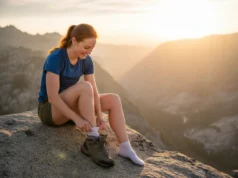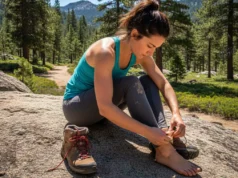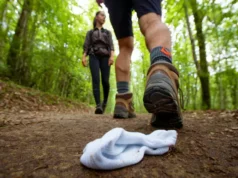In this article
You’re six miles into a long-awaited ridgeline hike, the sky a perfect, crisp blue, but you’re not having an enjoyable hiking experience. Instead, your entire world has shrunk, your focus narrowed to a single, searing point of pain on your heel—a hotspot that’s quickly, inevitably, becoming a trip-ending blister. We’ve all been there. A great hike is built from the ground up, and that foundation doesn’t start with your hiking boots; it starts with the socks for trekking you pull on before you even touch them. This isn’t about brand loyalty or subjective opinions. This is a data-driven guide that moves beyond that, providing a framework to transform your socks from a potential liability into your most reliable piece of outdoor apparel. We’re here to ensure your socks, with the right anti-blister features and moisture-wicking capability, become a source of comfort and performance, not pain, whether on short day hikes or long backpacking trips.
This guide will empower you to:
- Master the Five Pillars of Performance: Learn why Comfort & Fit, Durability, Moisture Management, Thermoregulation, and Odor Resistance are the non-negotiable criteria for any trekking sock.
- Decode the “Genetic Code”: Understand how fabric composition (Merino vs. Synthetics) and cushioning level dictate a sock’s on-trail behavior.
- Match Your Sock to Your Mission: Discover our top-rated sock recommendations, specifically curated for three distinct hiker profiles: The Thru-Hiker, The Day Hiker, and The Ultralight Trail Runner.
- Invest in a System, Not Just a Sock: Grasp the critical relationship between sock height and your footwear to create a truly blister-proof system.
How to Choose the Right Socks For Trekking: An Expert’s Framework
This section is designed to arm you with objective knowledge. Our goal is to answer the question of how to choose hiking socks, turning you from a consumer overwhelmed by choices into an informed gear analyst, capable of making a smart, confident decision based on material science and real-world needs, not just marketing.
Why Do Fit and Material Choice Matter Most?
The Sock as an Interface: Think of a sock not as clothing, but as a critical interface—a seamless, protective gasket between the soft tissues of your foot and the rigid, unforgiving interior of your boot. Every single job it has stems from perfecting this interface. Any failure, whether it’s a seam that rubs, a heel that slips, or fabric that bunches underfoot, directly introduces friction. And over thousands of steps, friction is the undisputed architect of the blister, making a sock’s inherent anti-blister features paramount.
The Science of Fit: A high-performance sock shouldn’t just sit on your foot; it should have a snug fit. This is where the science comes in. Proper fit and sizing are everything, whether you have a narrow foot profile or wider feet. Elastic fibers like Spandex or Lycra aren’t just for comfort; they are structural components that create a contoured, anatomical fit. These fibers provide tension to hug the arch, preventing the sock from shifting, and grip the ankle to stop it from sliding down—a critical function related to sock height, from no-show to crew to over-the-calf. When you see a feature like a seamless toe, don’t dismiss it as marketing fluff. It’s a critical piece of engineering that eliminates a major friction point.
Pro-Tip: When buying new hiking socks, always try them on with the specific hiking boots or trail runners you’ll be wearing. The total volume of the sock and your foot inside the shoe is what determines the final fit. A sock that feels perfect in a sneaker might be too compressive inside a snug leather boot.
The “Genetic Code” of Fabric: The fabric composition on a sock’s packaging is its genetic code—it tells you exactly how it will behave on the trail. This is a game of fundamental trade-offs. A high percentage of Merino wool, for example, programs the sock for a high warmth rating, incredible thermoregulation, and an excellent odor resistance rating, often using wool with sustainability certifications like RWS wool. Conversely, a higher percentage of nylon or polyester in the merino wool blend prioritizes a high durability rating and improves its breathability / dry-time rating, creating a fantastic fast-drying sock.
Why Cotton is a Catastrophic Failure: There’s a reason experienced hikers say “cotton kills.” It’s not hyperbole. Cotton is hydrophilic; it loves when a sock grab moisture. It absorbs sweat and holds onto it tenaciously. This leads to soft, waterlogged skin that is incredibly fragile and extremely vulnerable to friction. Lacking any effective moisture-wicking properties, it is, without question, the worst possible choice for any outdoor adventures.
This core understanding of fit and material forms the foundation for evaluating every other aspect of a sock’s performance. For a deeper dive into the science of performance sock materials, it’s important to recognize how these specialized fabrics are fundamentally different and superior to casual socks. The American Academy of Dermatology’s research on blister prevention corroborates this, citing friction and moisture as the primary causes—the very two things performance socks are engineered to defeat.
| Performance Attribute | High-Merino Blend (>60% Wool) | High-Synthetic Blend (>50% Nylon) |
|---|---|---|
| Odor Resistance | ⭐️⭐️⭐️⭐️⭐️ Excellent. Merino wool naturally resists odor-causing bacteria, keeping your feet fresh. | ⭐️⭐️ Fair. Synthetic fibers can trap odors, though some are treated to help. |
| Durability | ⭐️⭐️ Fair. Merino wool fibers are not as strong and can be prone to wear and pilling over time. | ⭐️⭐️⭐️⭐️⭐️ Excellent. Nylon and polyester are exceptionally tough, providing superior resistance to abrasion. |
| Warmth When Wet | ⭐️⭐️⭐️⭐️ Very Good. Merino wool continues to provide insulation even when it’s damp or wet. | ⭐️⭐️⭐️ Good. Synthetics retain some insulating properties when wet, but are not as effective as wool. |
| Dry Speed | ⭐️⭐️ Fair. Merino wool absorbs moisture and is slower to dry. | ⭐️⭐️⭐️⭐️⭐️ Excellent. Synthetic fibers wick moisture away and dry very quickly. |
Our Selection Process: How We Built This Guide
To build your absolute trust, we believe in total transparency. This guide isn’t based on what we like; it’s based on a rigorous, data-driven process designed to find the best hiking socks for your specific needs on the trail.
Our Commitment to Objectivity: This guide is the result of a comprehensive analysis of reviews from hiking experts, data from extensive field tests, material science literature, and aggregated user feedback. We didn’t just wear these socks; we studied their construction, stress-tested their materials, and measured their performance against a defined set of criteria.
The Evaluation Framework: Every product recommended in this guide was rigorously evaluated against the five core performance criteria: Comfort & Fit, Durability, Moisture Management, Warmth Rating, and Odor Resistance. A sock only makes this list if it excels across this entire spectrum, not just in one or two categories.
How We Selected the Products: We began by identifying the most common hiker archetypes, or “personas,” to understand real-world needs. The demands of a thru-hiker on the Pacific Crest Trail are fundamentally different from those of a weekend warrior in the Appalachians. We then curated products that best solve the specific problems faced by each persona, ensuring a perfect match between your gear bag and your trip profile.
Pro-Tip: On a multi-day trip, your socks are a system. At the end of the day, swap to your dry camp socks. Turn your hiking socks inside out and hang them from your pack or a tree branch. Exposing the moisture-rich interior to air dramatically speeds up dry time, ensuring they are ready for the morning.
A Note on Affiliate Links: If you purchase through links in this article, we may earn a small commission at no extra cost to you. This helps support our work and allows us to keep testing gear. However, our recommendations are based solely on performance and data. We are fiercely independent and recommend only what we believe is best.
The Best Socks For Trekking of 2025: Our Top Recommendations for Every Need
Here they are: the top recommendations curated for the key user personas we identified in our research. This is where the data meets the trail, empowering you to make a final, confident choice that will serve you for hundreds of miles of trekking.
Our Top Picks for The Thru-Hiker & High-Mileage Backpacker
This is the avid hiker who measures trips in weeks, not days, and for whom gear failure is a logistical crisis. They are the ultimate gear testers, demanding unconditional durability, multi-day odor resistance, and long-term comfort for multi-day backpacking trips. For them, weight savings and reliability from brands like Darn Tough or Farm to Feet are paramount.
Our Top Picks for The All-Season Day Hiker & Weekender
This is the core enthusiast. They invest in versatile, high-quality gear like the Smartwool Performance Hike Light that works just as well for a Saturday morning hike as it does for a three-day backpacking trip. They value a perfect balance of comfort, performance, and strong value, needing a sock with the right cushioning level and breathability for all-day wear.
Our Top Picks for The Ultralight Trail Runner & Fastpacker
This user is obsessed with speed, efficiency, and minimalism where every gram of weight savings counts. Their primary concerns are managing intense heat and moisture, making breathable and moisture-wicking performance critical for summer running and fastpacking. For this specialized use-case, using a synthetic sock like the Feetures Elite Light Cushion Quarter or a unique toe-sock from Injinji is all about eliminating friction.
Conclusion
Your sock is a piece of technical equipment, not an accessory. Its performance is dictated by material science and construction, not by color or brand logos. The merino wool blend with Nylon represents a critical trade-off between comfort/odor resistance and a high durability rating/dry time. The cushioning level—from light cushion to full cushion—serves a dual purpose: shock absorption and insulation, directly affecting its warmth rating. Finally, a sock’s warranty is a direct signal of its engineered durability; a lifetime warranty reframes a higher initial price as a smart, long-term investment for many treks to come.
Stop letting the wrong socks dictate the quality of your hike. Use this framework to invest in the right pair for your feet and your adventures, and turn your focus from your feet back to the trail ahead. Happy hiking!
Frequently Asked Questions about Socks For Trekking
What is the best material for trekking socks, Merino wool or synthetic?
For the vast majority of hikers, a blend dominated by Merino wool is the best choice due to its superior comfort, outstanding thermoregulation in a wide range of conditions, and natural ability to resist odor over multiple days. However, synthetic-heavy blends, like those found in the Farm to Feet Damascus or the Darn Tough Light Hiker, are excellent choices for consistently wet and humid environments where faster drying times become the top priority.
How many pairs of socks should I bring for a multi-day backpacking trip?
The gold standard is the three-sock system: one pair to wear, one pair to dry (often hanging on your pack), and one clean, dry warm sleeping sock reserved exclusively for recovery. This rotation is critical for preventing blisters and maintaining foot health. With a high-quality, odor-resistant sock like the Darn Tough Hiker Micro Crew, experienced thru-hikers can often get by with just two pairs to save weight, but the three-pair system offers the best margin of safety.
What sock height is best for hiking boots?
The rule is simple and non-negotiable: the sock cuff must always extend above the top of your footwear to prevent painful chafing from the boot collar. For mid- or high-cut hiking boots, a Crew or Micro Crew height is the standard. A taller sock provides more protection for your legs. Lower-cut quarter socks should only be paired with trail running shoes or low-cut hiking shoes.
Are liner socks still necessary to prevent blisters?
While once popular, thin sock liners are now largely obsolete. Modern, single-sock systems made with advanced materials and construction offer superior moisture management and a better fit, which effectively eliminates the need for a liner sock. For those with persistent blister problems, specialized designs like the double-layer WrightSock Coolmesh II or the five-toed Injinji Trail Midweight are far more effective modern solutions than a traditional liner.
Risk Disclaimer: Hiking, trekking, backpacking, and all related outdoor activities involve inherent risks which may result in serious injury, illness, or death. The information provided on The Hiking Tribe is for educational and informational purposes only. While we strive for accuracy, information on trails, gear, techniques, and safety is not a substitute for your own best judgment and thorough preparation. Trail conditions, weather, and other environmental factors change rapidly and may differ from what is described on this site. Always check with official sources like park services for the most current alerts and conditions. Never undertake a hike beyond your abilities and always be prepared for the unexpected. By using this website, you agree that you are solely responsible for your own safety. Any reliance you place on our content is strictly at your own risk, and you assume all liability for your actions and decisions in the outdoors. The Hiking Tribe and its authors will not be held liable for any injury, damage, or loss sustained in connection with the use of the information herein.
Affiliate Disclosure: We are a participant in the Amazon Services LLC Associates Program, an affiliate advertising program designed to provide a means for us to earn advertising fees by advertising and linking to Amazon.com. As an Amazon Associate, we earn from qualifying purchases. We also participate in other affiliate programs and may receive a commission on products purchased through our links, at no extra cost to you. Additional terms are found in the terms of service.





